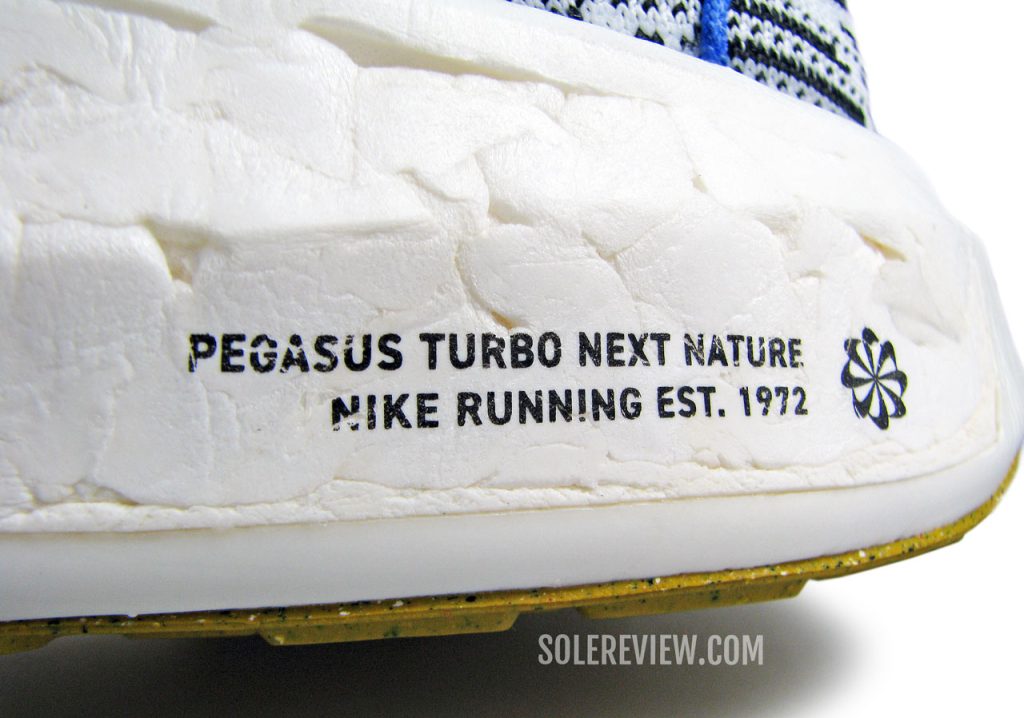
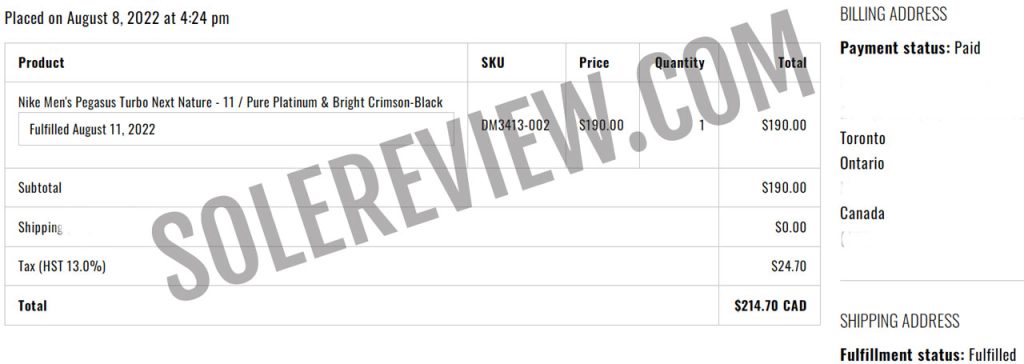
The Nike Pegasus Turbo Next Nature was purchased at full retail price for our review. The amount is in Canadian Dollars.
In this review:
INTRODUCTION
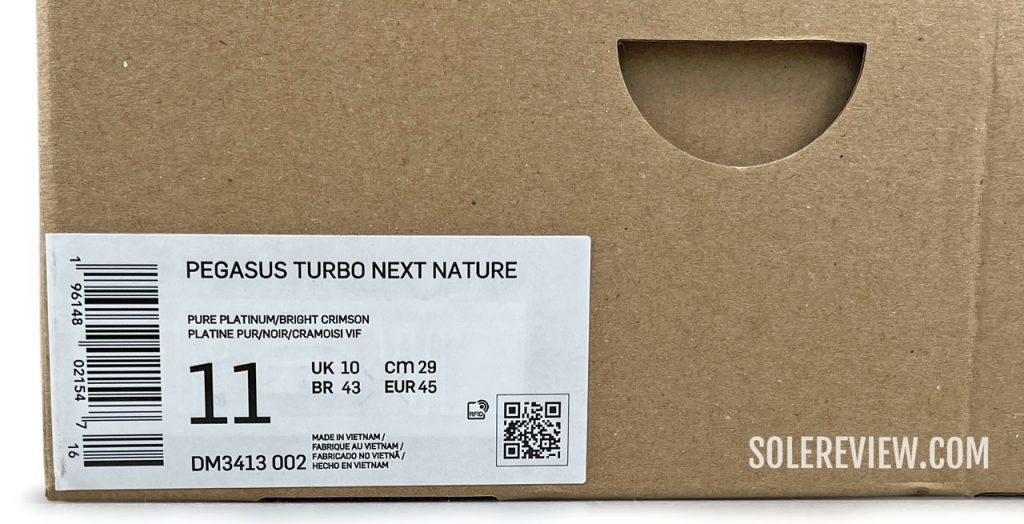
Keeping in line with the sustainability theme, the plain cardboard shoe box is devoid of printing or color.
This review is a story of wasted potential.
On the surface, the Pegasus Turbo Next Nature (referred to as NXT from here) has many things going for it.
For example, the midsole offers a very comfortable ride – thanks to the dual-density ZoomX foam. It’s also bouncier and softer than the Pegasus 39.
The secure upper fits true to size. The outsole traction is good, if not great. And at just 9 ounces, the shoe offers a high cushioning-to-weight ratio.
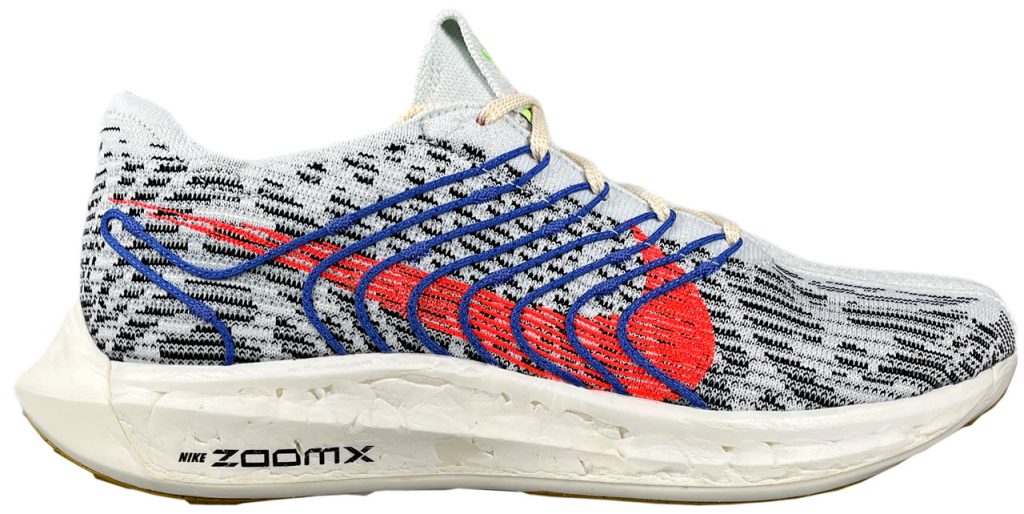
Nike goes in a brand-new direction with the Turbo NXT, and thus strays from what made the Turbo 1 and 2 popular.
However, Nike Turbo should be a much better running shoe. It should have improved the Turbo NXT by using the Turbo 1 and 2 as a benchmark, by which we mean a better quality of transitions and upper fit.
Later in this review, we’ll revisit the previous Turbo versions for a balanced discussion of the potential have and have-nots.
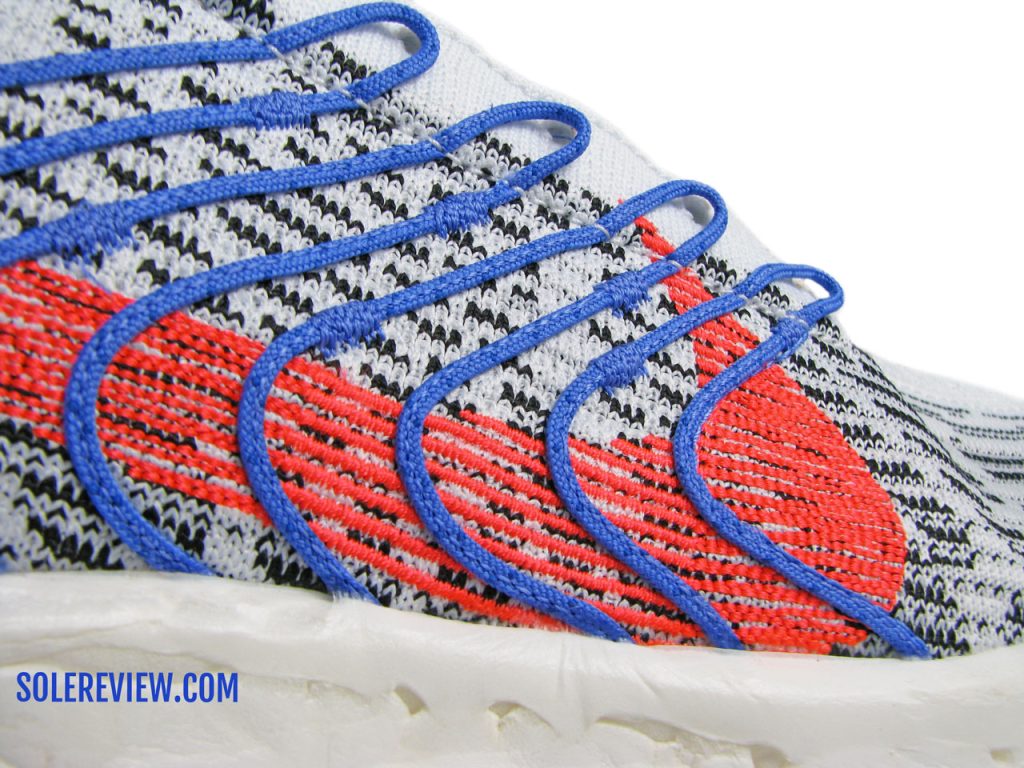
The ‘Next Nature’ design prioritizes form over function.
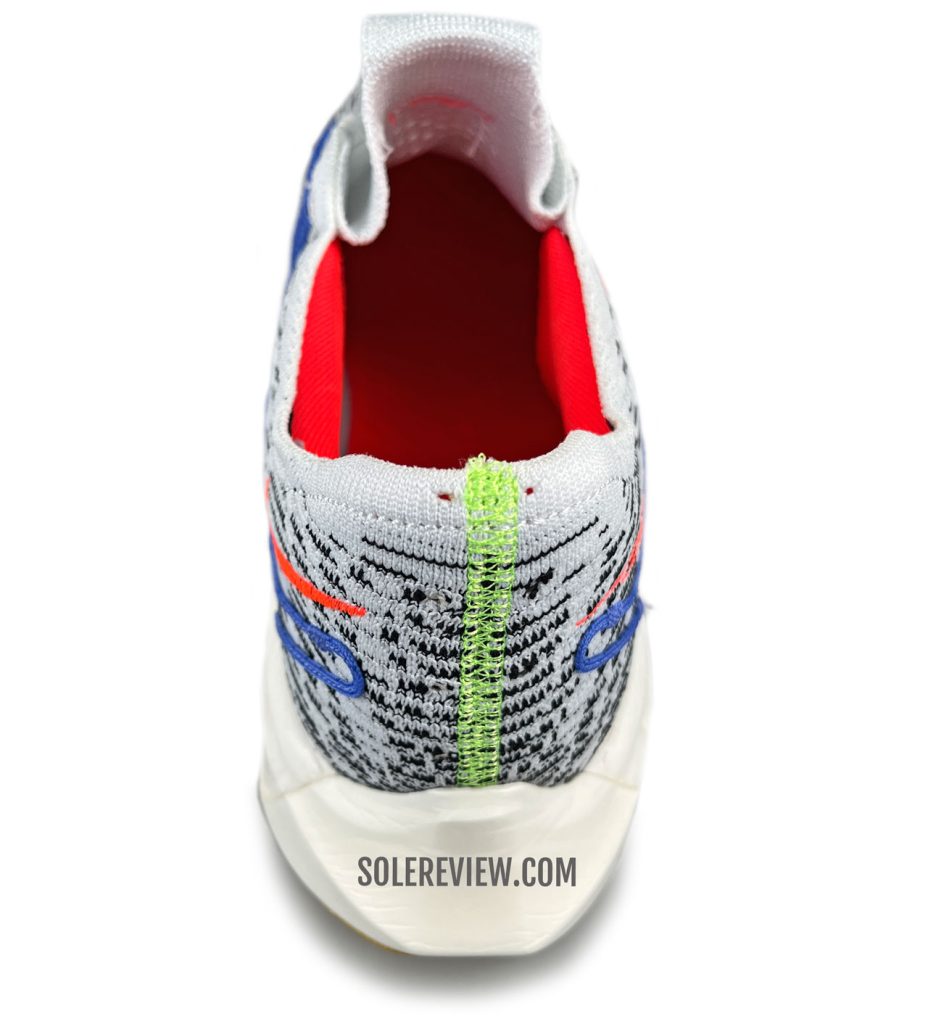
The narrow heel opening and non-elastic tongue make wearing the Turbo a minor struggle.
It could have also chosen to make the Turbo look like a regular running shoe, while using recycled materials to achieve a conforming upper fit.
For example, the sleeved upper has a narrow opening, but there’s barely any stretch in the tongue. The upper edge near the last lacing row feels stiff over the foot, and there’s no tongue padding to filter the pressure.
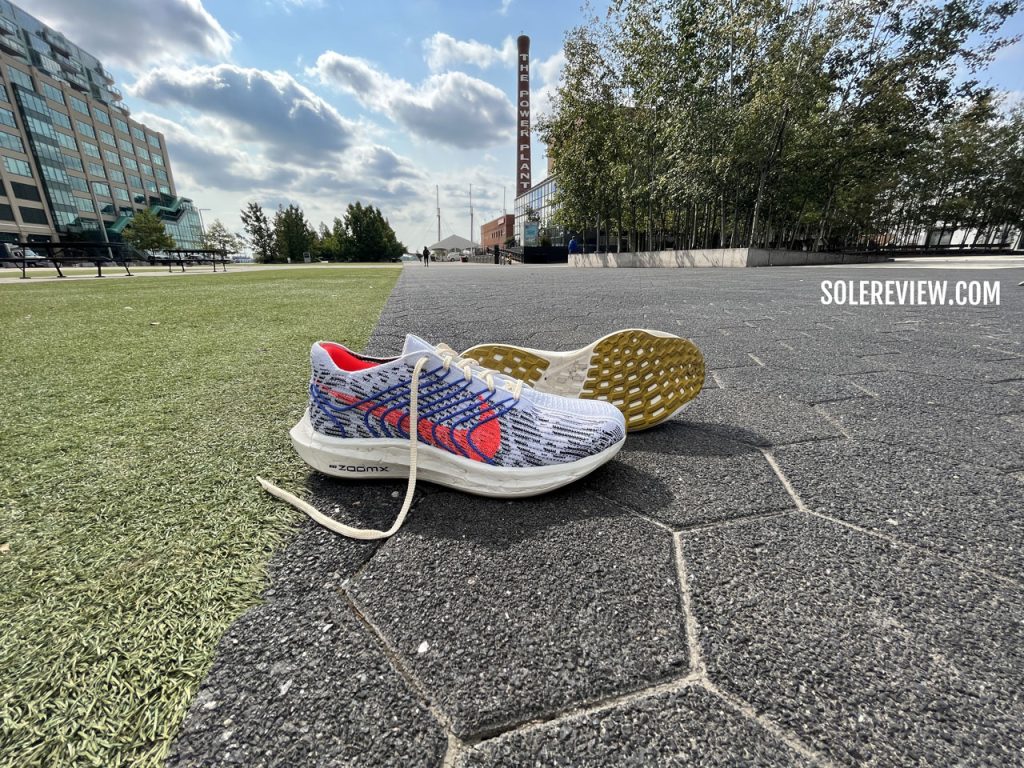
On the Pegasus Turbo Next Nature, Nike went overboard with the recycled aesthetic that adds little to no functional value.
They should have known better, as shoes like the Space Hippie exist for the reason – they’re meant for a different market segment. Not every shoe needs to look like they’re made out of recycled scraps. And if they do, the on-road performance should not suffer as a consequence.
THE NIKE PEGASUS TURBO NEXT NATURE COMPARED WITH PEGASUS TURBO 1 AND 2
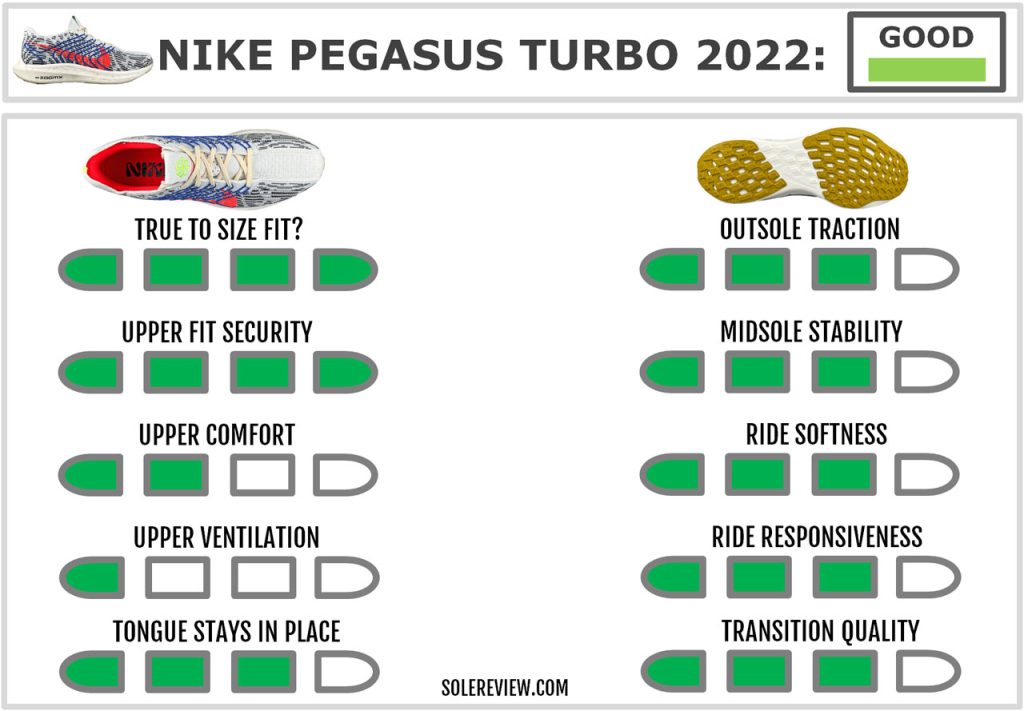
Unlike the Pegasus Turbo 1 and 2, the Pegasus NXT doesn’t have a firmer React foam base. The midsole is 100% ZoomX, so there’s greater ride comfort over longer distances.
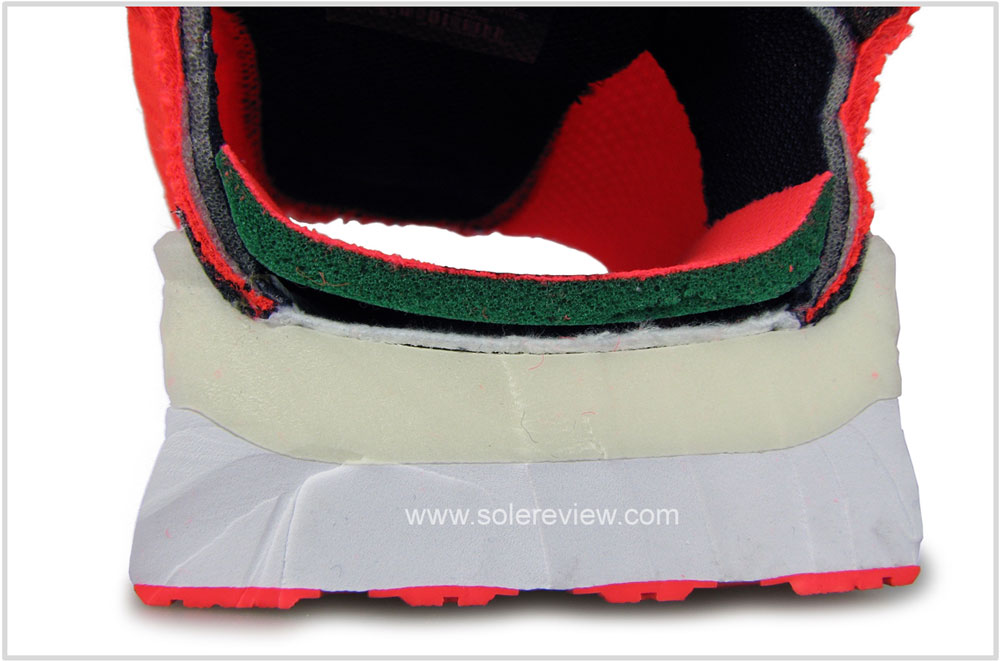
The Pegasus Turbo 1 and 2 had two things the Next Nature does not – a firmer React base at the bottom and a cushy insole on top.
But there’s a caveat – since the new model (unofficially the Nike Pegasus Turbo 3) replaces the cushy footbed of the V1 and V2, the ride feels firmer just under the foot. The thin insole lacks the soft step-in softness that the older Turbo’s had.
Also, the lack of a firm foundation dials down the ‘Turbo’ part of the ride character. The last two Turbo’s had 50:50 distribution of Reach and ZoomX – three years ago, we took the shoe apart to find out.
To sum up, the past version was a better shoe for tempo runs, whereas the NXT’s higher level of ride comfort makes it a better long-distance trainer.
When compared with the Turbo V1 and V2, the Pegasus NXT’s upper is a mixed bag.
On one hand, the upper fits true to size – and that is an improvement over the uber-shallow toe-box of the first two models – man people blamed the bowling shoe ‘stripe’ for the shallow fit, but we said that wasn’t the case – it was the last.
On the flip side, the upper panels are thick and lack elasticity. As a result, entering and exiting the shoe is a slight struggle, and the mesh feels stiff over the forefoot. The Turbo 1 and 2 fared poorly on ventilation, and the Turbo NXT is no better.
Also, the shallow and racer-like upper fit of the previous Turbos pinned the foot down over the soft insole and ZoomX foam. This enhanced the sense of cushioning responsiveness and feedback, something that is missing this time.
We’re not implying that the shallow fit was a good thing, but that is one of the many reasons why the new Turbo feels different than the 2019 model.
THE MIDSOLE DESIGN AND RIDE EXPERIENCE
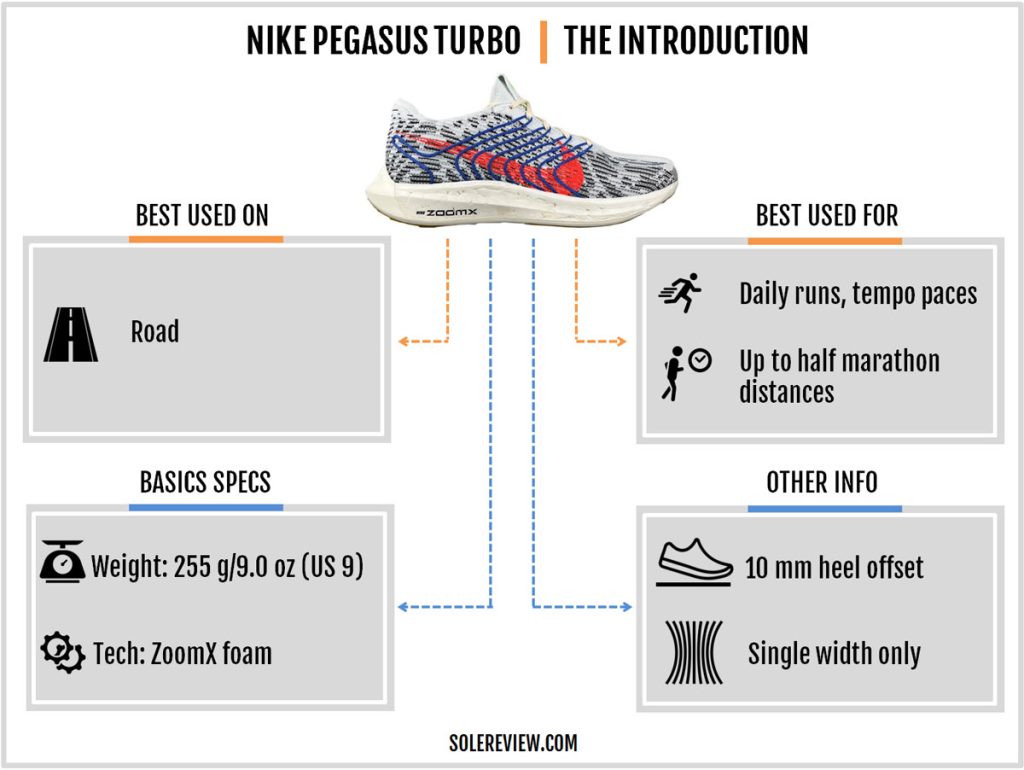
This is our third review of a Nike running shoe that has a 100% ZoomX midsole, with the other two being the Streakfly and Invincible Run. A pattern is starting to emerge, and the gist is as follows.
(Note: Soon after publishing this review, a few of our readers mentioned that the second foam may not be ZoomX, but Nike’s SR-02 foam. This is unconfirmed, since the SR-02 foam we’re acquainted with is a completely different material. For now, we assume it’s ZoomX, since that’s what it feels like.)
When the cushioning of a running shoe depends entirely on ZoomX foam, the result isn’t a magic bullet that works for all use cases. While ZoomX foam is soft and bouncy, there are limits to what it can achieve on the road.
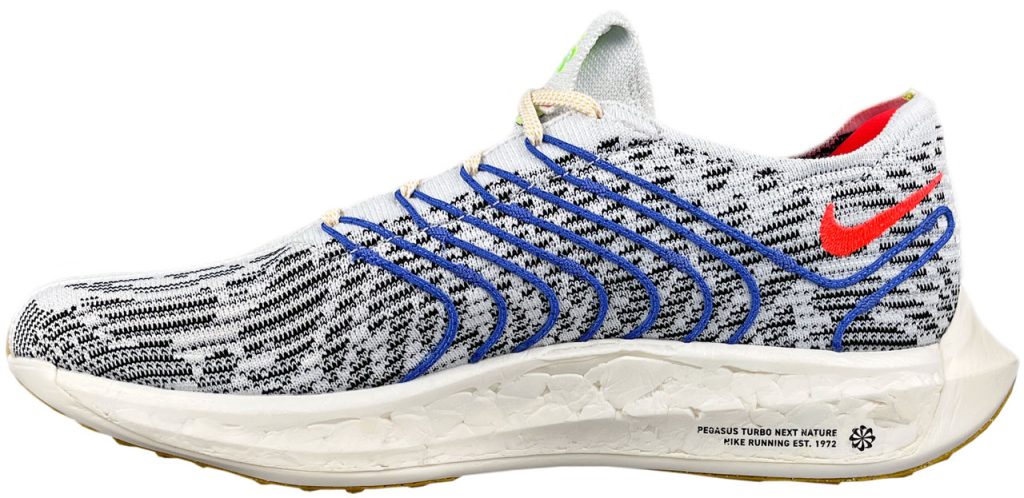
ZoomX foam isn’t the one-size-fits-all solution.
On shoes like the Invincible Run, the high-volume ZoomX midsole works exactly as intended. It offers a superbly plush ride that makes easy runs a very comfortable experience. The wide midsole and plastic clip add stability where necessary.
However, a running shoe that’s supposed to perform well under higher speeds – 4:30 min/km (7:00 min/mile) and faster – needs more than just ZoomX foam. For example, despite a low-profile ZoomX midsole, the Streakfly doesn’t feel particularly agile. That applies to the new Turbo as well.
It’s becoming clear that any ZoomX Nike running shoe that’s designed for quicker paces needs to have a firmer component as a chaperon. After all, the Carbon plate is the reason why the Vaporfly Next% works so well.
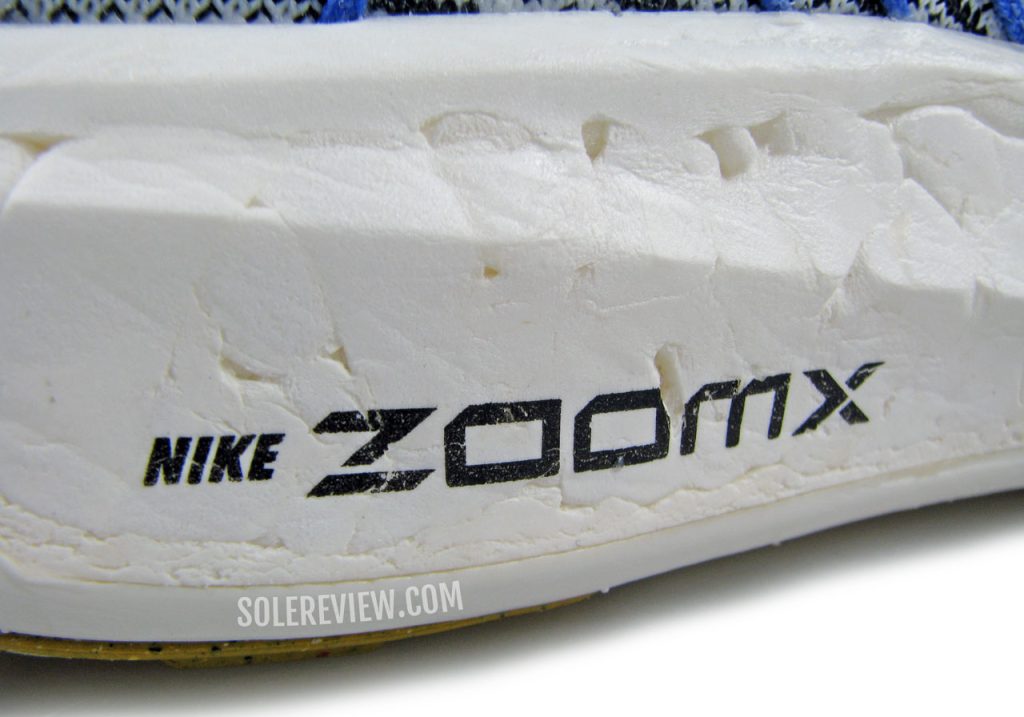
The ZoomX foam midsole; pictured here is the recycled ‘Next Nature’ foam that uses fused scraps.
The Pegasus Turbo NXT is missing a critical component that made the Pegasus Turbo V1 and V2 moderately successful – a firmer layer of React foam under ZoomX. Love it or hate it, the React layer was an important ingredient of the ride character.
Our dissection showed that the ZoomX and React foam were stacked in a 50:50 configuration. The firmer base allowed the transition process to be efficient by preventing the foot from sinking into the midsole during the take-off phase.
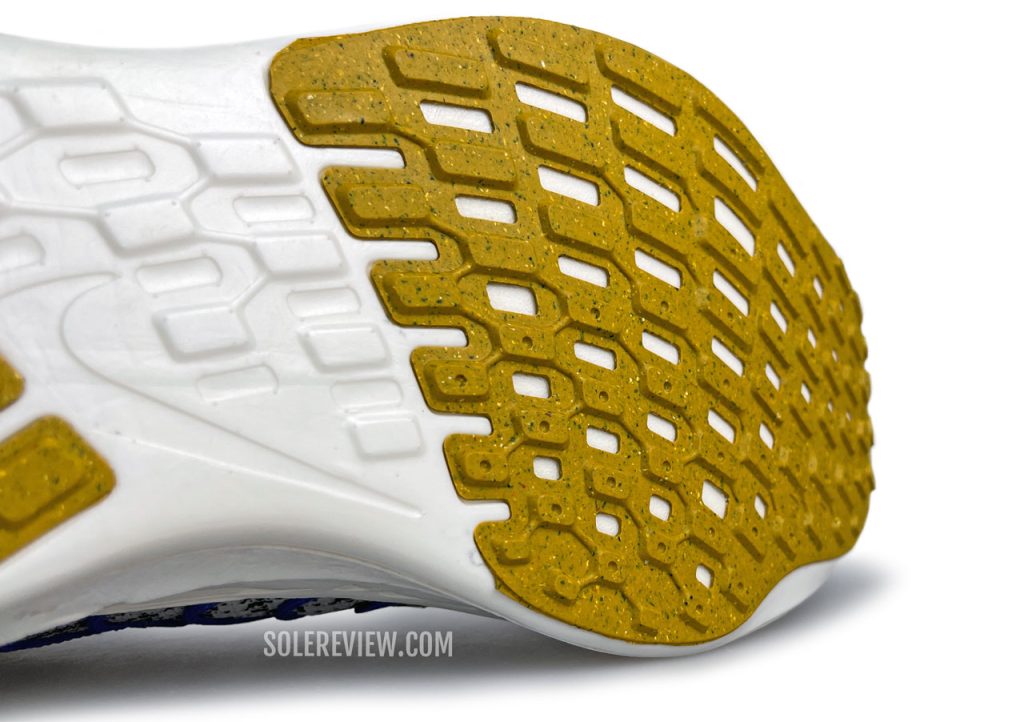
Depending on the shoe, a little stiffness or rocker profile can be a good thing.
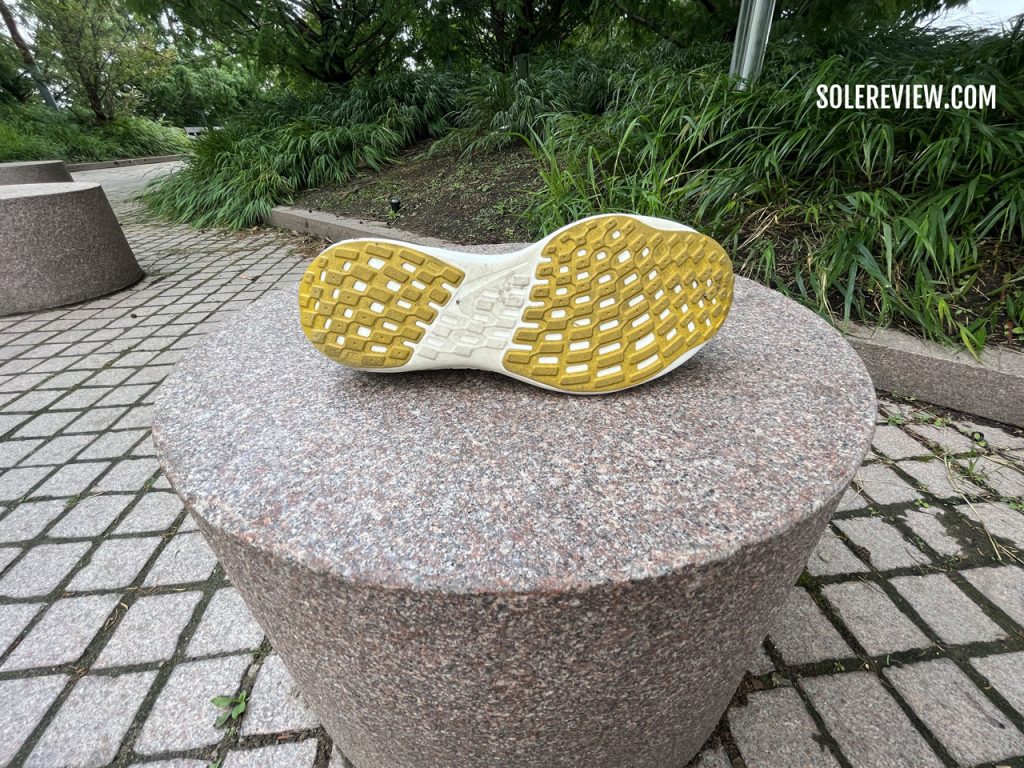
When it comes to a tempo-friendly running shoe, having the firmer foam closer to the ground is optimal. A firmer base also improves the outsole grip to enhance the ‘touch and go’ effect.
The firmer base could come in the form of a thick forefoot that acts as a rocker (Asics Novablast, Hoka Clifton, Nike Vaporfly) or in the shape of a firmer layer or plate.
As the Nike Pegasus Turbo NXT lacks either, the foot has to work harder through the push-off phase than, say, the Turbo 1 and 2.
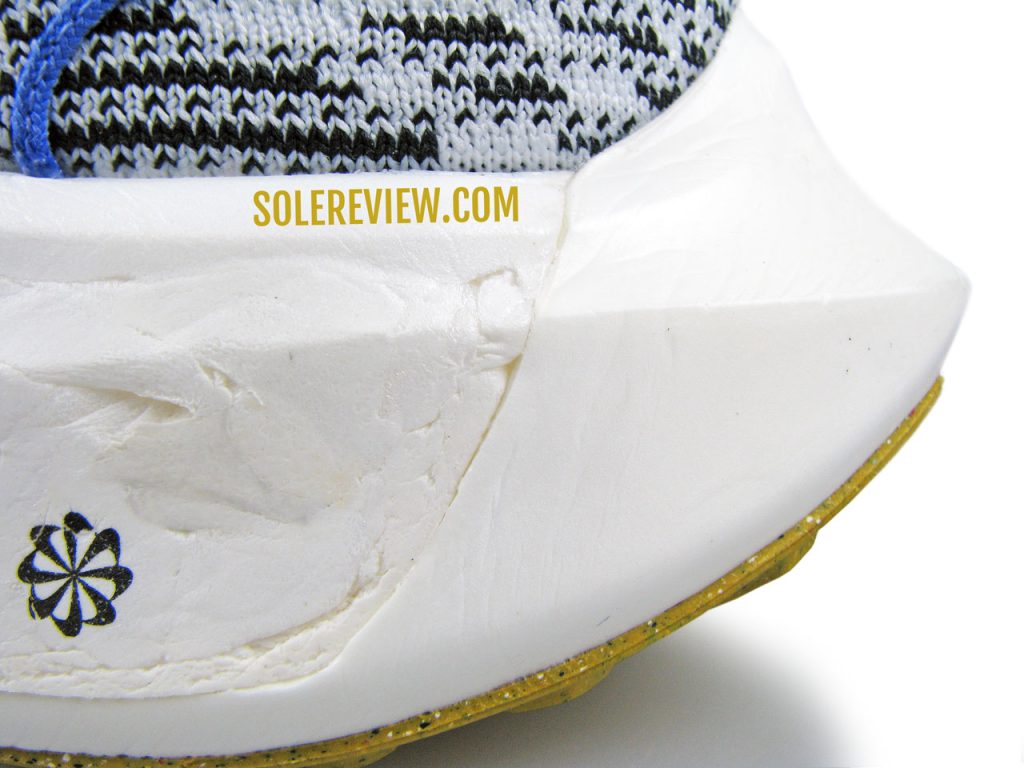
The joint line between the ‘virgin’ ZoomX (rear) and recycled ZoomX (front) adds some stiffness.
The closest thing that Turbo Next Nature has to a firm layer is the joint line between the two densities of ZoomX foam.
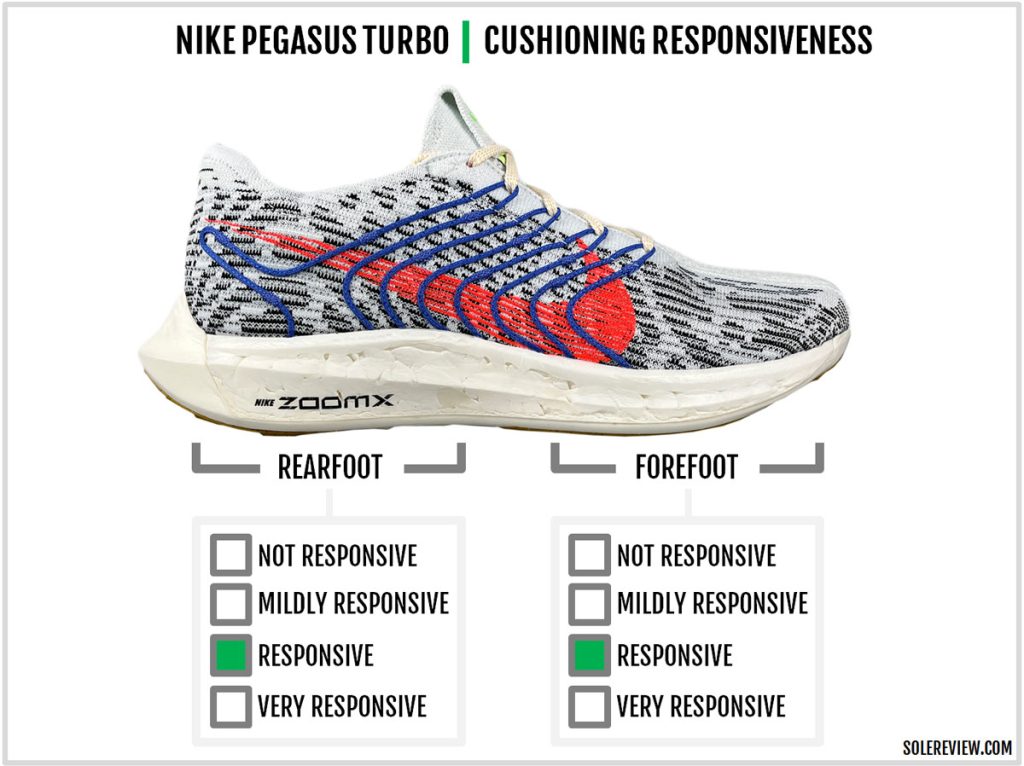
However, that’s no substitute for React. At best, the new midsole offers a bouncy softness that doesn’t feel mushy. Another way to view the Pegasus Turbo NXT would be to do so as a more cushioned version of the Streakfly.
It’s a versatile running shoe for speeds up to 4:30 min/km (7:00 min/mile) and is comfortable enough for runs up to a half marathon. Its range is limited by the warm and stiff upper which is also difficult to slip in and out of.
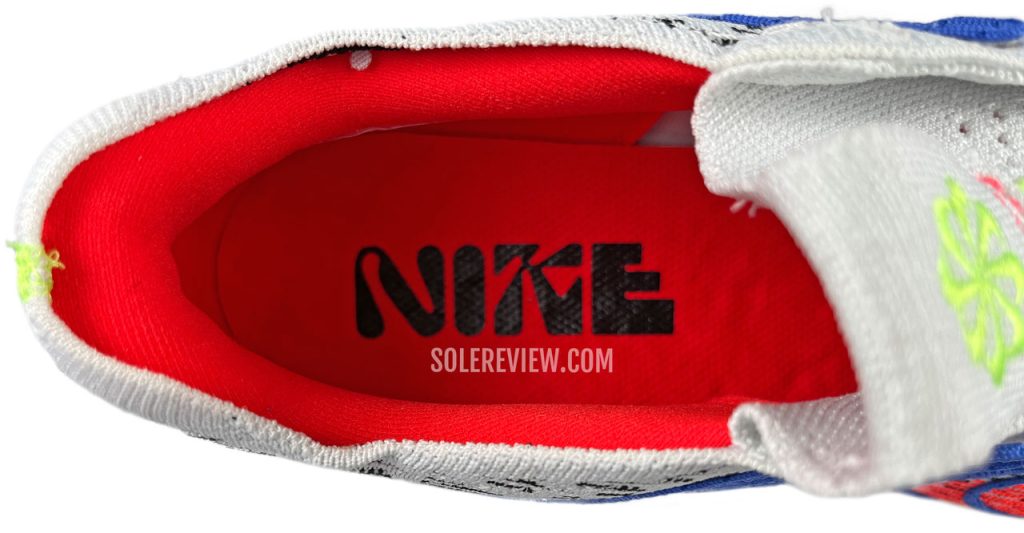
Unlike the Turbo 1 and 2, the insole is now non-removable and much thinner. This results in a lower level of step-in softness.
Oddly enough, despite the 100% ZoomX midsole, the latest Turbo has a lower level of step-in softness than the 2019 model. That’s because the insole is now ultra-thin and non-removable. Turn it over, and the insole is made of fused slivers of foam scraps.
In contrast, the V1 and V2 had a thick insole that increased underfoot comfort. As a result, some runners may find the NXT to be ‘stiffer’ or firmer than the Turbo V1 and V2.
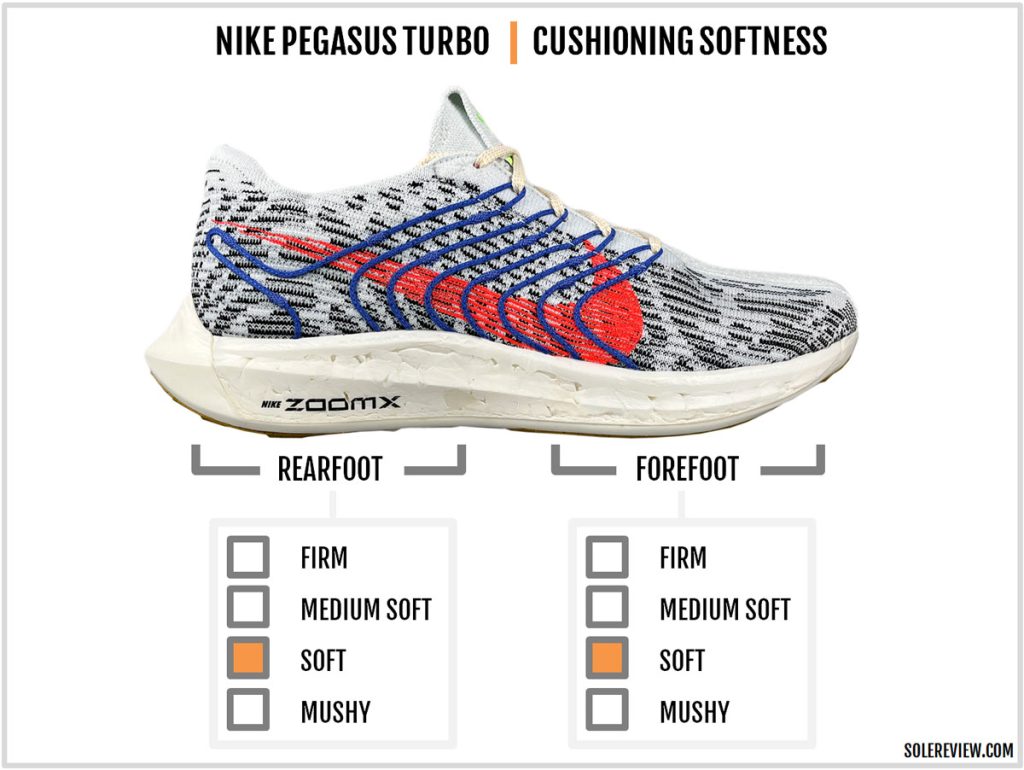
It’s also worth pointing out that the firmer React base and ultra-shallow upper fit (of the V1 and V2) allowed the softer layer of ZoomX to compress fully. That made the Turbo V1 and V2’s cushioning softer closer to the foot. As you can see, the sensory aspect of ‘cushioning’ isn’t just about the stack height or ZoomX volume.
We called out the Turbo V1 and V2’s tendency to bend in the center in the midsole; the 2022 Turbo corrects that. Now the midsole flexes in the forefoot – just like it’s supposed to.
Nike doesn’t advertise the heel-to-toe offset, but we sense that it’s 8 – 10 mm. Nonetheless, the Turbo NXT works for all foot-strike orientations.
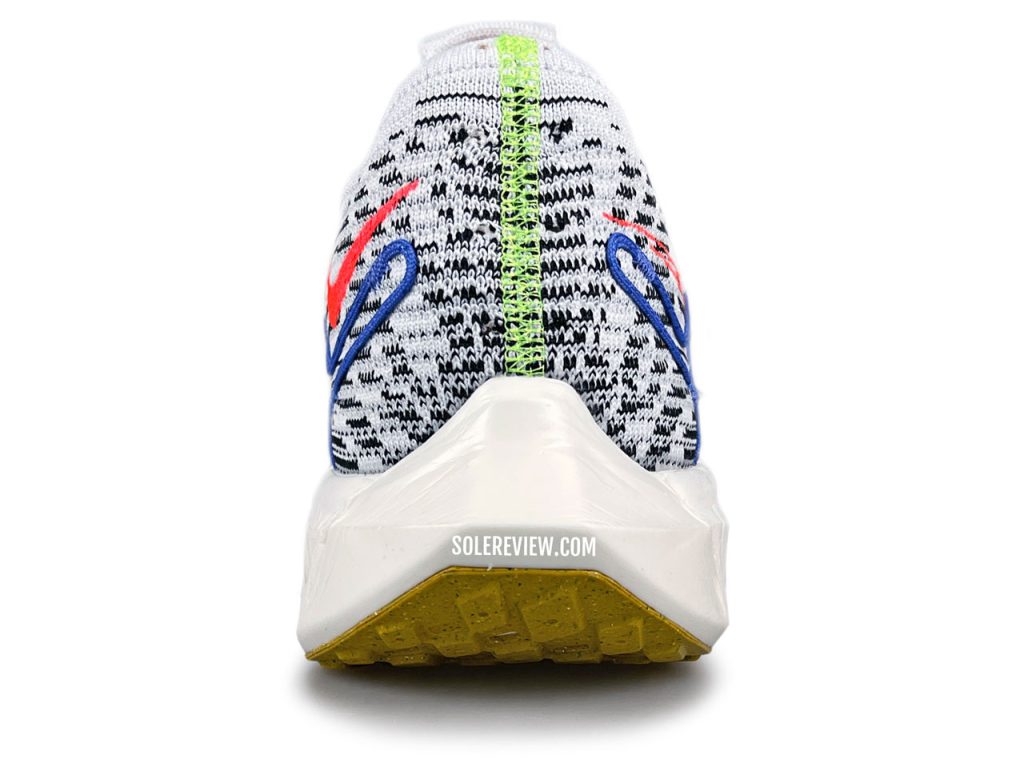
The Turbo NXT works equally well for forefoot and heel strikers. The ride is neutral and isn’t lacking in support.
The beveled heel doesn’t catch the ground, and the ride is very neutral due to the evenly-designed midsole. The stability is decent, and the glued joint line (between the two ZoomX foams) acts as a supportive element.
The outsole traction was better than we expected.
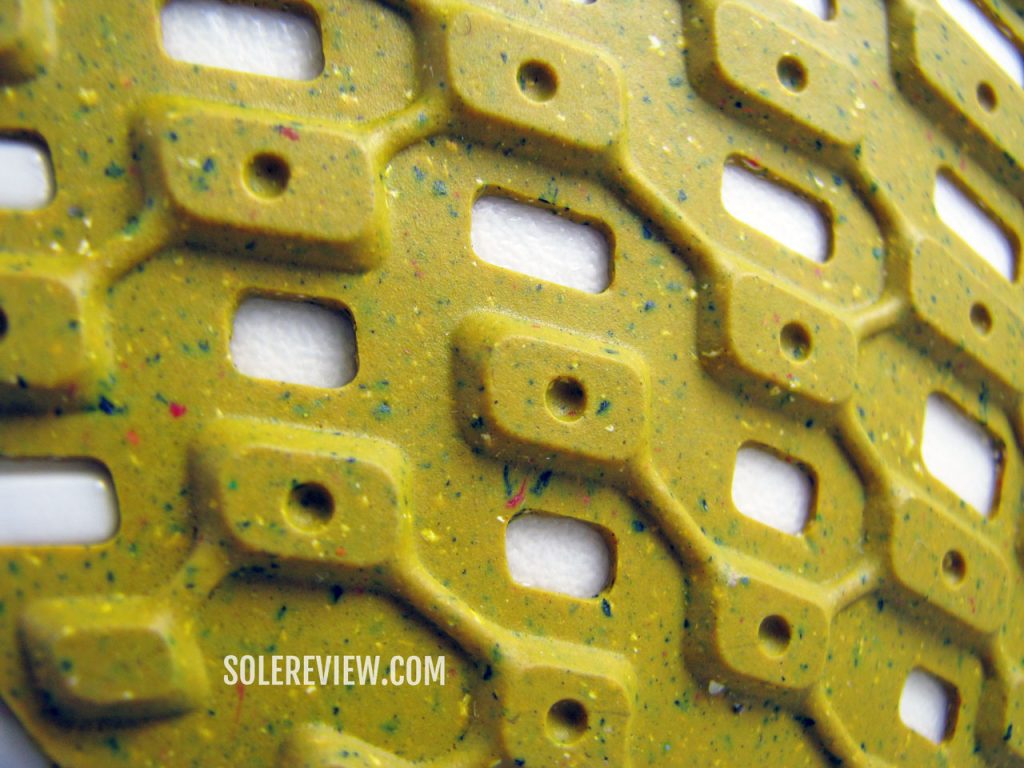
The outsole traction is satisfactory; seen here is what we assume Nike Regrind – a rubber compound with recycled content.
The forefoot and heel are covered with rubber – and recycled (Nike regrind), we assume. It’s not the best on wet roads, but for all other use cases, there’s no dearth of grip. The thin rubber slabs keep the weight in check.
RECOMMENDED ROTATION
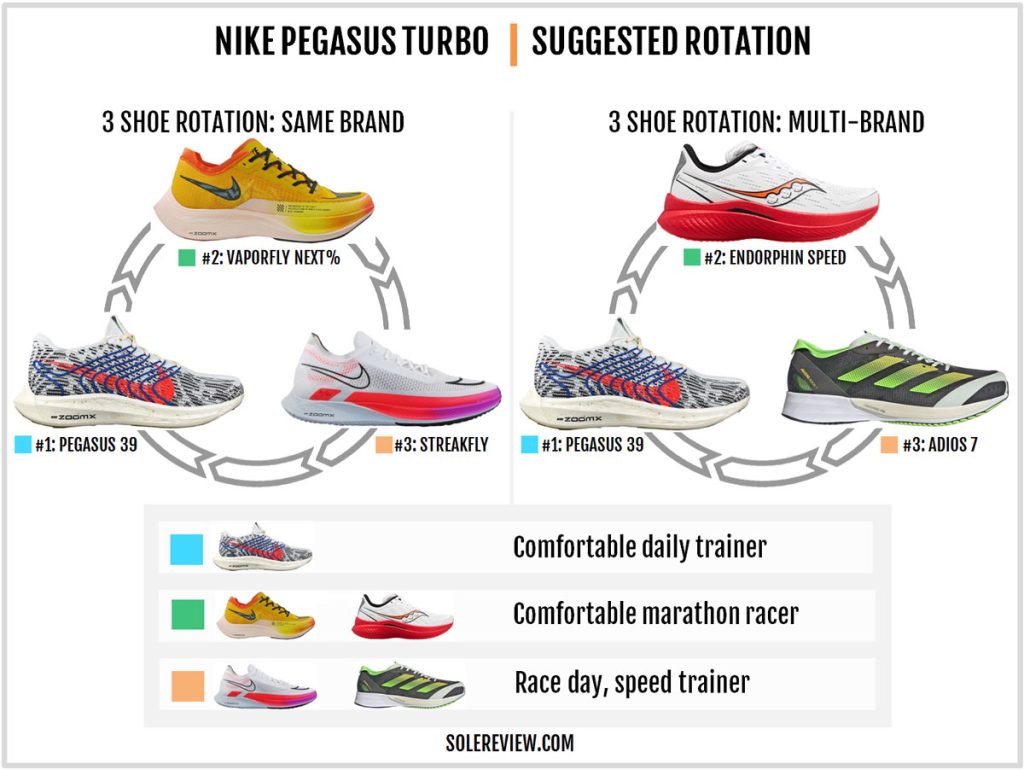
We’ll recommend the same rotation that we did for the Pegasus 39. The Turbo NXT is your daily trainer, whereas the Vaporfly Next V2% is the ideal marathon day pick.
The Saucony Endorphin Speed and Pro 3 are alternatives to the Vaporfly; the wider midsole(s) make them more stable than last year.
Though the Turbo has sufficient ride comfort for 26.2 miles, the stiff upper gets in the way of a distraction-free experience. For shorter races, the lightweight Nike ZoomX Streakfly is a good fit.
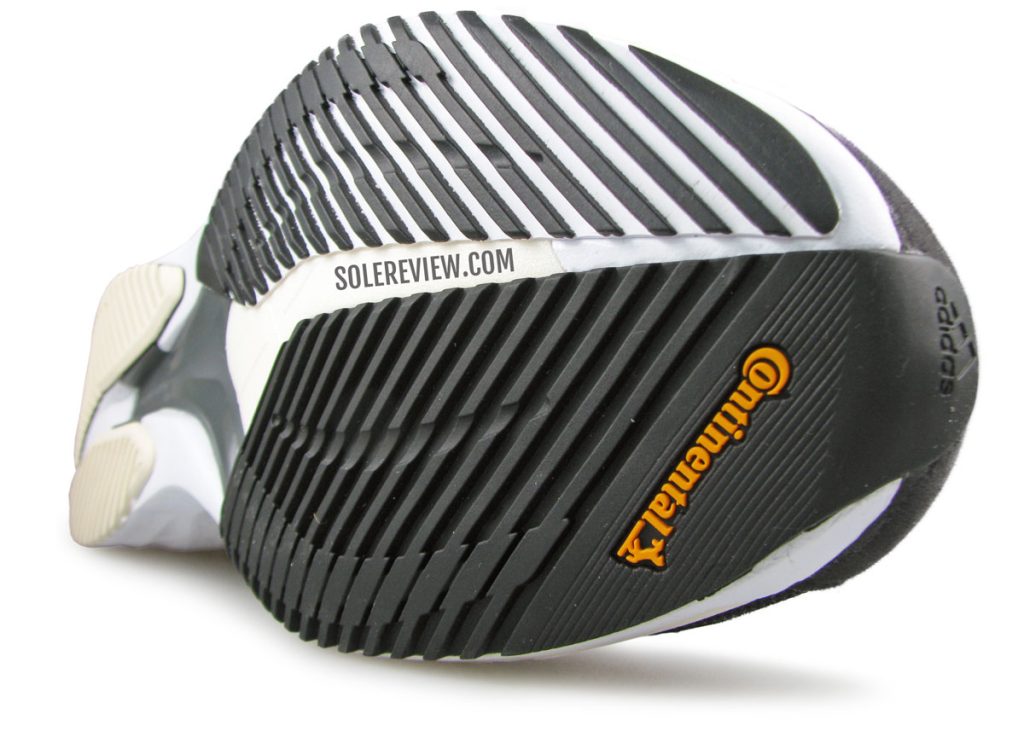
The adios 7’s outsole grip is phenomenal and excellent for quick races.
Our 5K and 10K pick would be the adidas adios 6 or 7 – though it’s much firmer than the Streakfly, that kind of ride quality is exactly what a sub 20 min 5K requires. The aggressive outsole grip of the Continental rubber outsole is a bonus.
IS THE NIKE PEGASUS TURBO NEXT NATURE DURABLE?
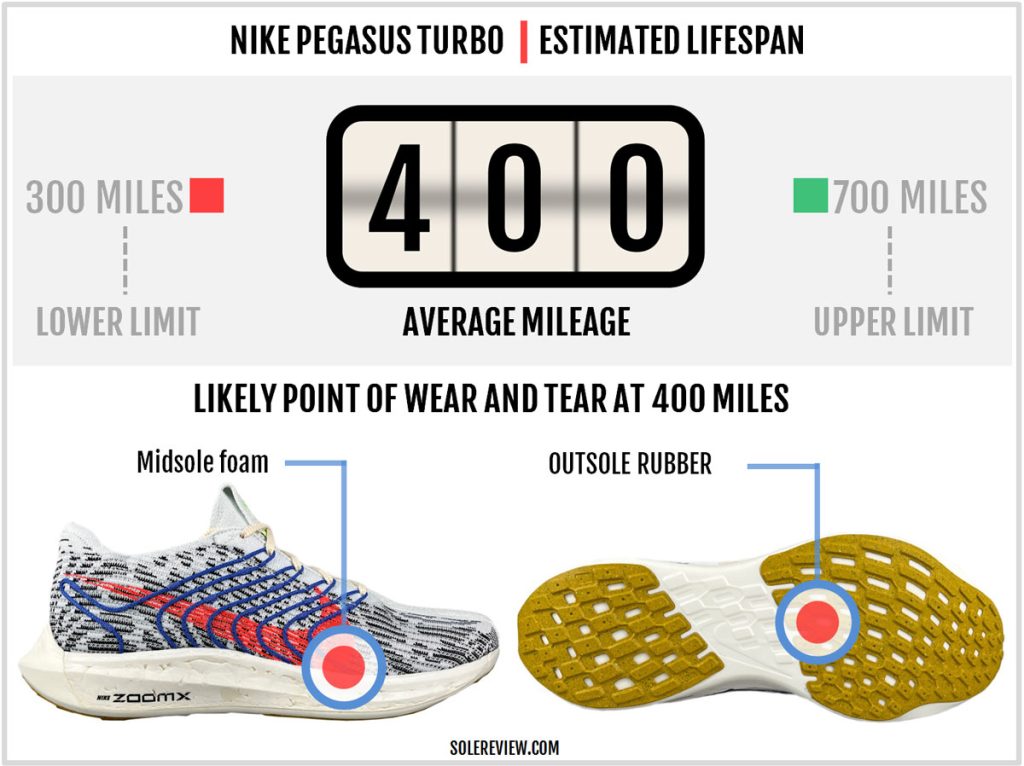
The upper fit isn’t perfect, and the interiors run warm. But there’s a silver lining to all that, and that’s durability. It’s highly unlikely that the Next Nature’s upper will fail prematurely, and it should outlast the rest of the shoe.
The ZoomX midsole will retain its cushioning over 300 miles, and by now, the creasing is a well-known outcome. However, that doesn’t affect the ride performance, and the recycled texture of the Turbo NXT’s ZoomX foam does a good job of concealing the creases.
Protecting the midsole is a two-piece rubber outsole. The soft rubber and cutouts make the outsole flexible, so it bends with the midsole to distribute the wear and tear.
THE UPPER DESIGN AND FIT
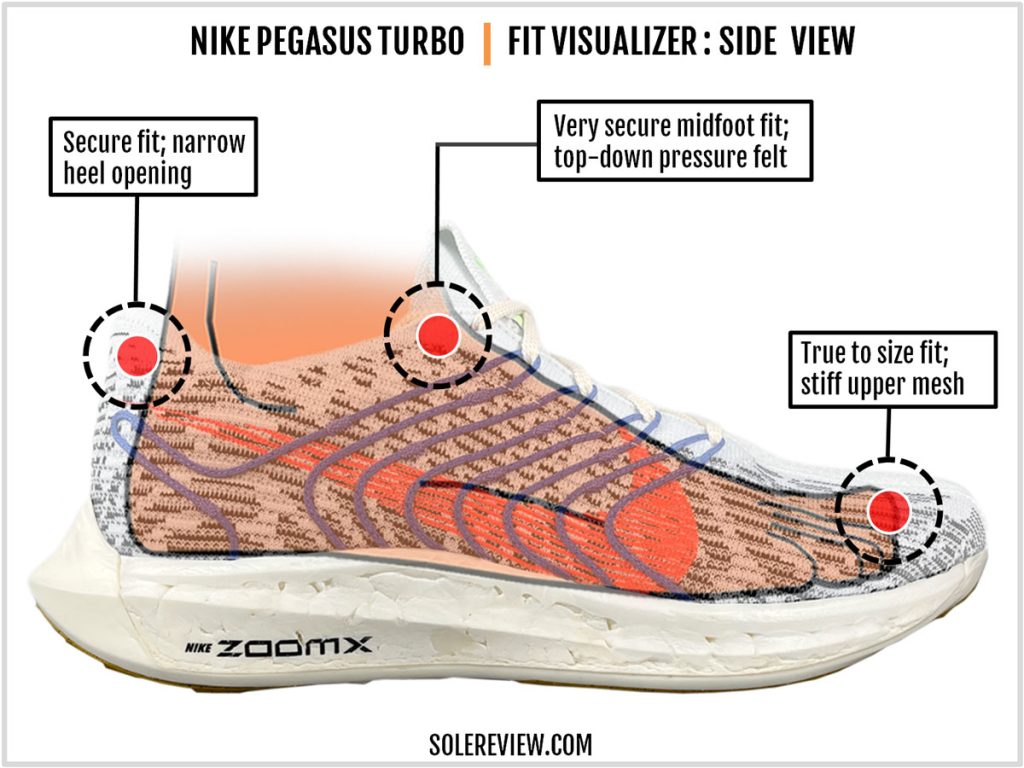
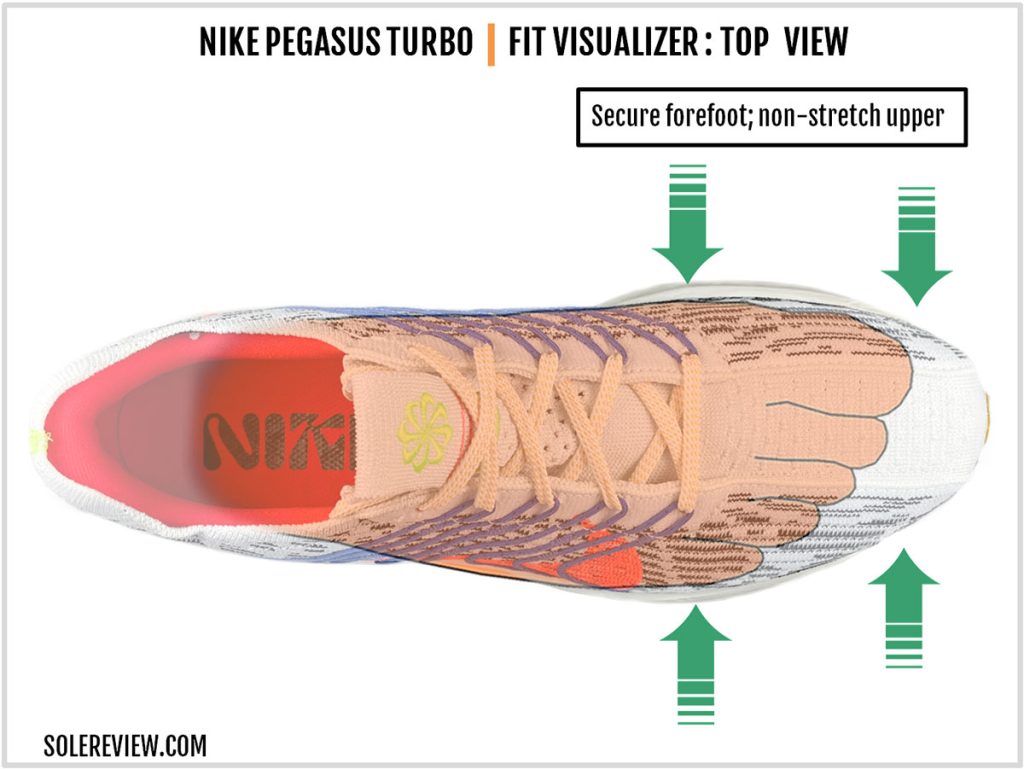
We’re not sure what Nike was thinking when they decided to pair this upper with the lightweight ZoomX midsole.
It’s one thing to use recycled content on a shoe upper, and another to try too hard to make it look recycled. Here, it’s clearly a case of form taking precedence over function.
Other Next Nature running shoes that look and behave ‘normal’ exist – the new Alphafly is a good example. Like the Turbo, it claims to use 50% recycled content, but without a stiff upper.
To give credit where it’s due, the brand claims that the upper is made of 100% recycled Flyknit yarns.
And unlike the Turbo 1 and 2, the upper fits true-to-size with a secure fit and balanced toe-box proportions. That being said, the standard width is all that we get – unlike the Pegasus 39, there isn’t an optional width.
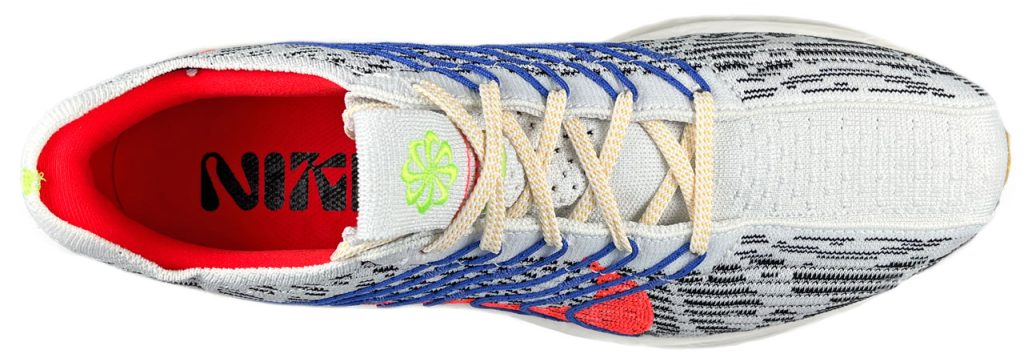
The upper has narrowly-spaced lacing over a sleeved tongue.
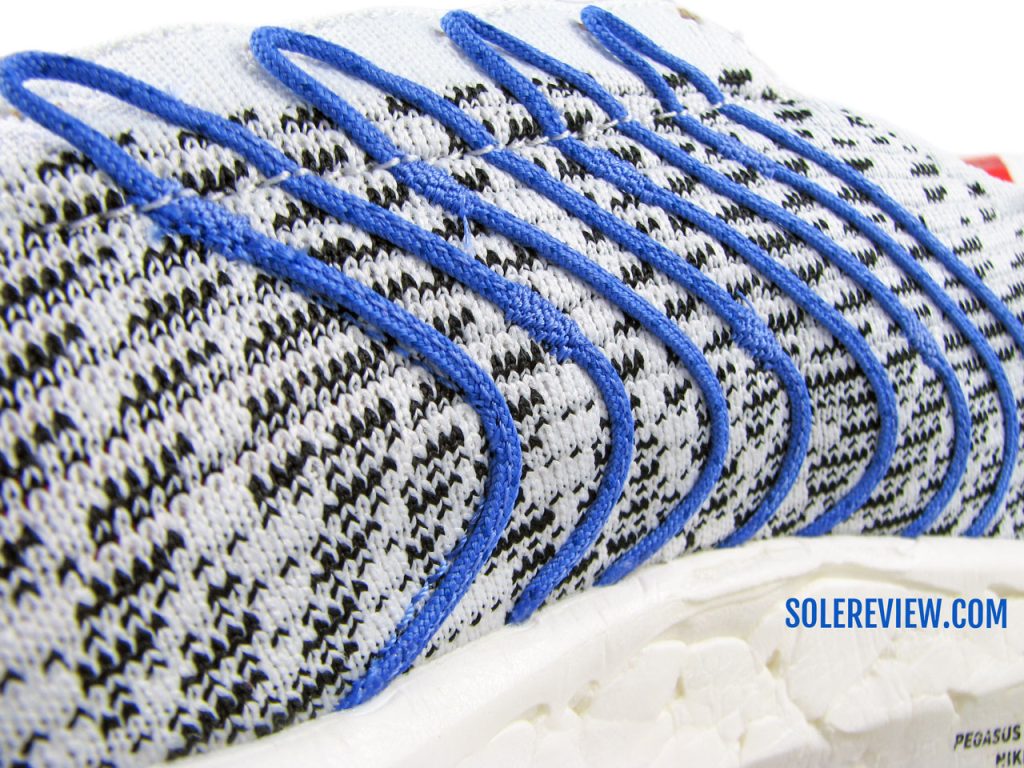
The ‘Flywire’ cords are merely cosmetic and do not provide a custom fit as they do on the Pegasus 39.
Even though the lacing relies on just five eyelets without an extra row for the runner’s loop, the midfoot and heel fit securely without slippage. The midfoot has ‘stitched-on’ cords that connect to the laces, but these are cosmetic – unlike the functional Flywire cords used on the Pegasus 39.
However, Nike went overboard with the whole Next Nature aesthetics, and the result is a shoe that feels more like a lifestyle sneaker than a performance running shoe.
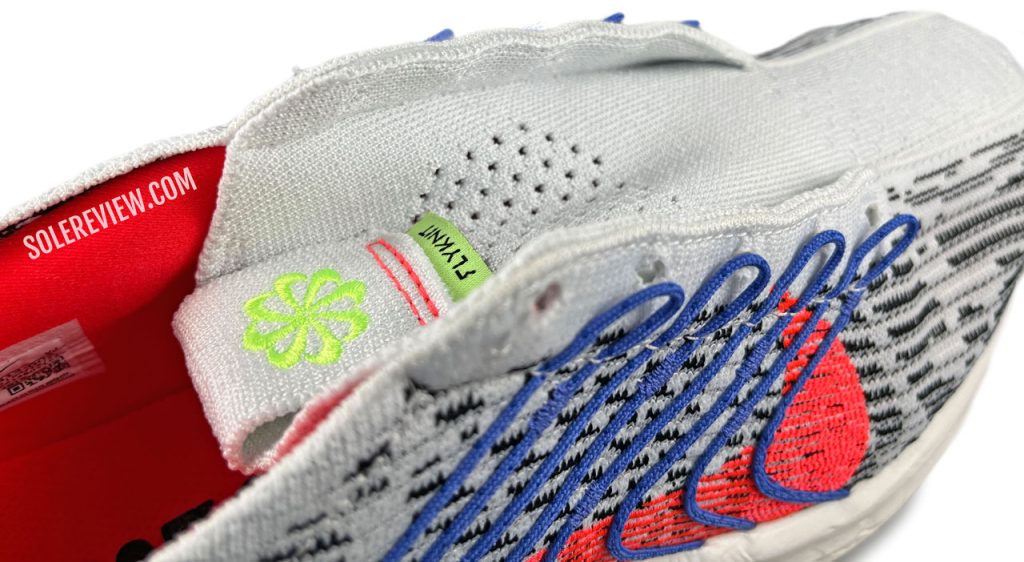
While sleeved, the tongue lacks any stretch. That makes it hard for wide feet to enter. When laced tight, the laces and side panels apply top-down pressure.
For example, despite a bootie entry with a sleeved tongue, the entry isn’t elastic. There’s a hint of a mechanical stretch, but that’s all there is to it. The heel opening isn’t very wide, so it will be a struggle for broad-footed folks to get inside the shoe.
Since the tongue lacks any padding, the lacing applies top-down pressure. This isn’t noticeable unless the shoe is cinched tight, so easing off on the lacing pressure will make most of that disappear.
But again, one shouldn’t have to worry about these small things on a $150 running shoe.
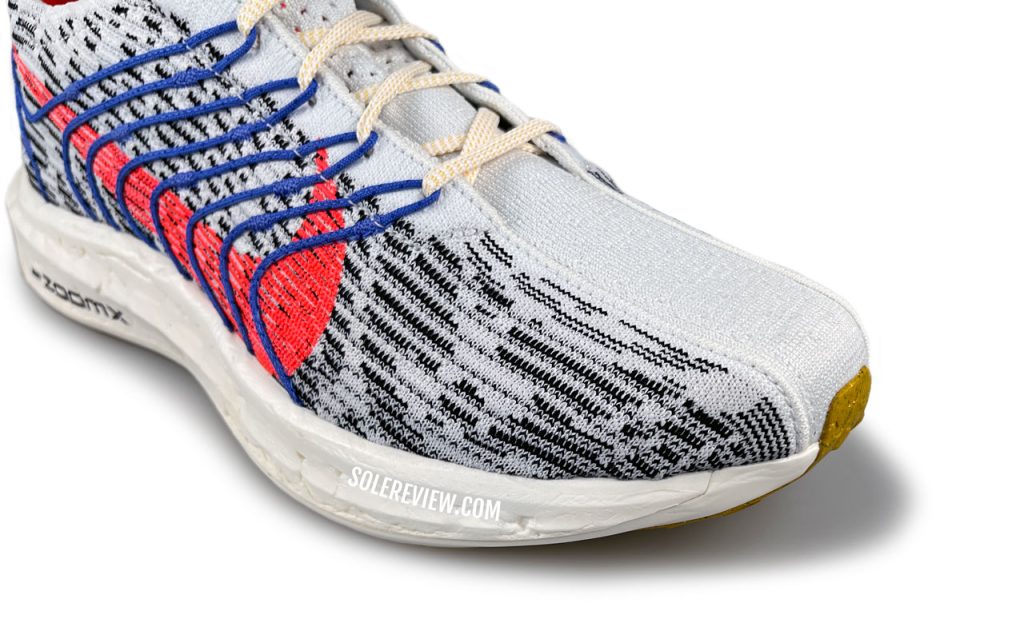
We like the true-to-size fit and toe-box height. That being said, the thick mesh tends to flex/press over the foot.
The thick upper also flexes on the forefoot during runs. While it’s not a source of discomfort, these are the minor things that separate a decent running shoe from a great one.
If you own a pair of Turbo and don’t think much of the mesh, try this. Run in the Pegasus Turbo NXT for 5K, and then immediately swap it for a pair of New Balance Fuelcell Rebel, Asics Novablast, or even the Pegasus 39 – and then run another couple of kilometers. The contrast is striking, and not in a flattering way.

The heel grip is great, but Nike should have made the tongue elastic (it isn’t) for ease of entry.
Slipping out of the shoe after a run also takes a bit of work. By the way, if you’re recovering from plantar fasciitis, we recommend avoiding the Nike Pegasus Turbo NXT altogether. The entry and egress can potentially aggravate sensitive plantar fascia.
What’s up with the Pegasus Turbo and PF tendon? The midsole of the Turbo 1 and 2 flexed in the midfoot. Though that’s fixed, but now it’s the turn of the new upper to misbehave.
It would have helped greatly if the tongue was elastic. While Nike is at it, they should also make the laces shorter by 1.5 mm – 2 mm; the narrow lacing configuration doesn’t require a lot of length.

The heel collar is padded, and the narrow counter molding is great at gripping the foot.
The heel fit is excellent, and most people will not miss the lack of the additional eyelet that allows for a runner’s loop. The heel collar uses soft lining and foam padding to keep the foot locked in. The internal heel counter has a narrow molding for a better grip around the heel.
The Pegasus Turbo Next Nature has mediocre ventilation, so it’s no better than the V1 and V2. By the way, those shoes also had their share of upper-related concerns.
However, the previous versions had a conforming upper fit that molded around the foot. That’s not the case with the Next Nature, and there are small pockets of space between the foot and mesh.
Again, it’s worth pointing out that the snug fit of the previous Turbo versions helped dial up the cushioning softness and responsiveness.
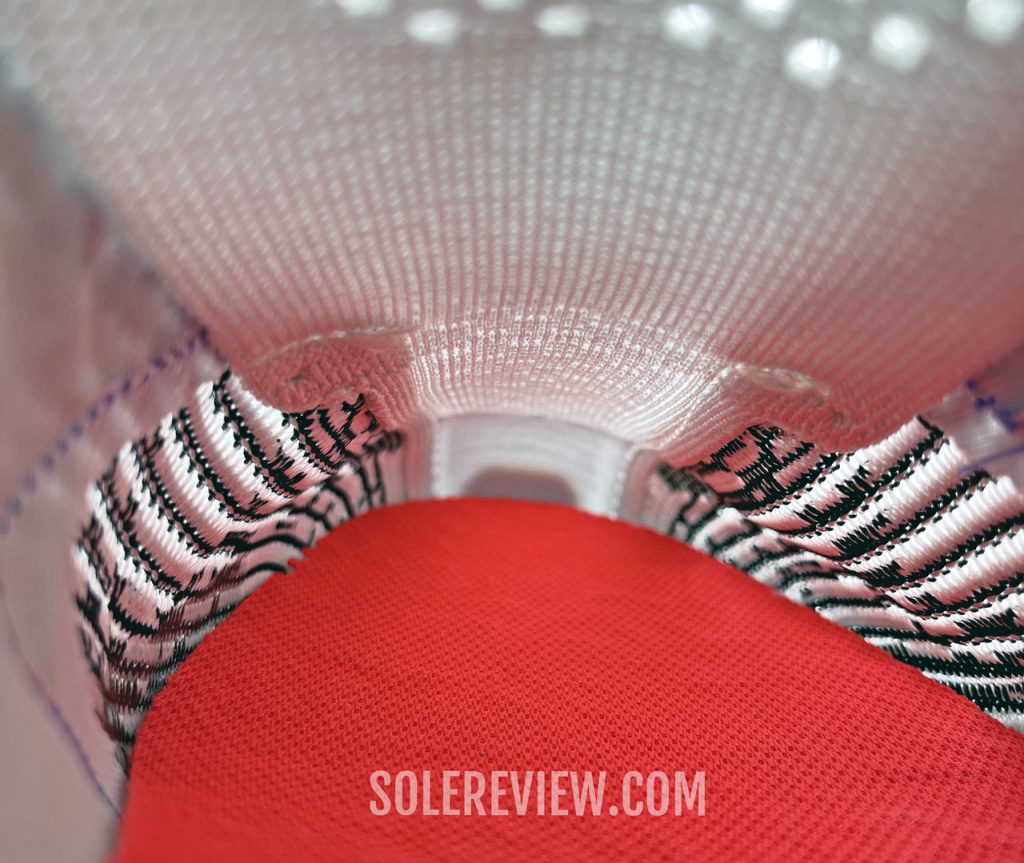
The forefoot and toe-box are unlined. The ventilation levels are below average.
This observation only applies to the forefoot; the midfoot and heel are form-fitting. This is because both the midfoot and heel use an additional lining, whereas the forefoot is unlined.
PROS AND CONS
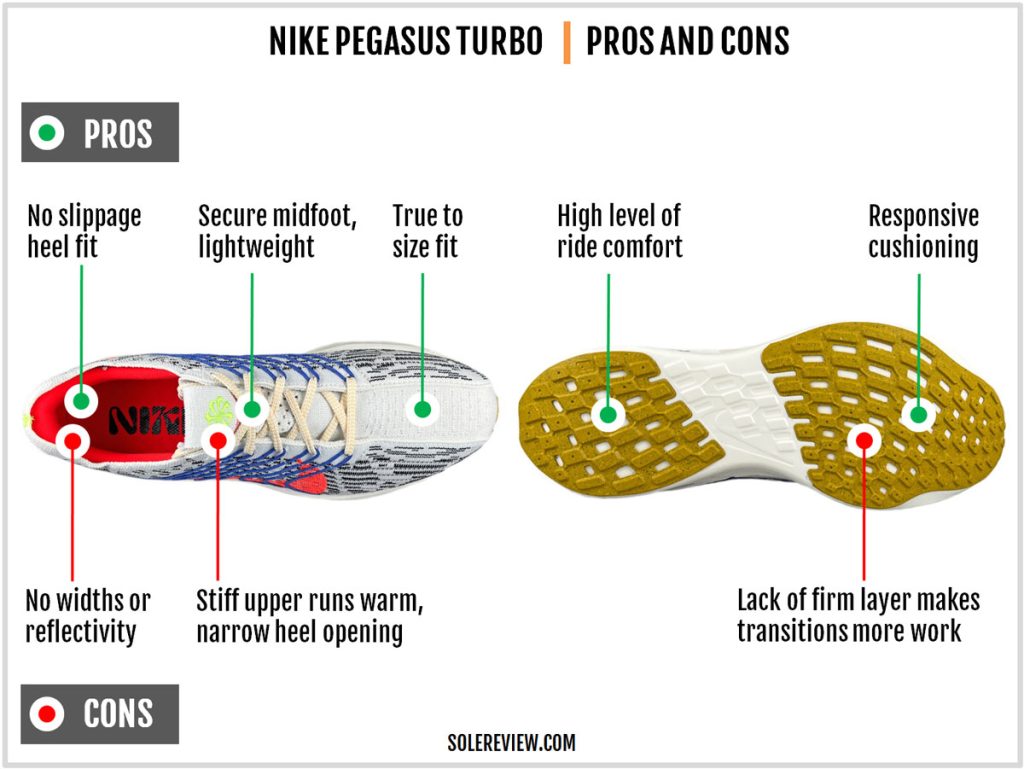
The ride comfort is excellent, and that’s not surprising considering that 100% of the midsole consists of ZoomX foam. The lively character of the foam also makes the Tempo Next Nature a cushioned daily trainer as well as a passable tempo trainer.
However, the upper is surprisingly average for a running shoe that’s supposed to be tempo-friendly.
The fit may be secure and true to size, but the mesh doesn’t quite conform to the foot. The upper does not ‘disappear’ over the foot; there’s a sense of stiff and unbreathable warmness. The stiff panels apply a slight top-down flexing pressure, and so do the laces.
Also, there are no widths, so the standard sizing is a take-it-or-leave-it deal.
The non-elastic tongue exacerbates the narrow heel opening, so runners with a wide instep will find it a challenge to get in and out of the shoe.
COMPARISON:
THE NIKE PEGASUS TURBO NEXT NATURE COMPARED WITH PEGASUS 39
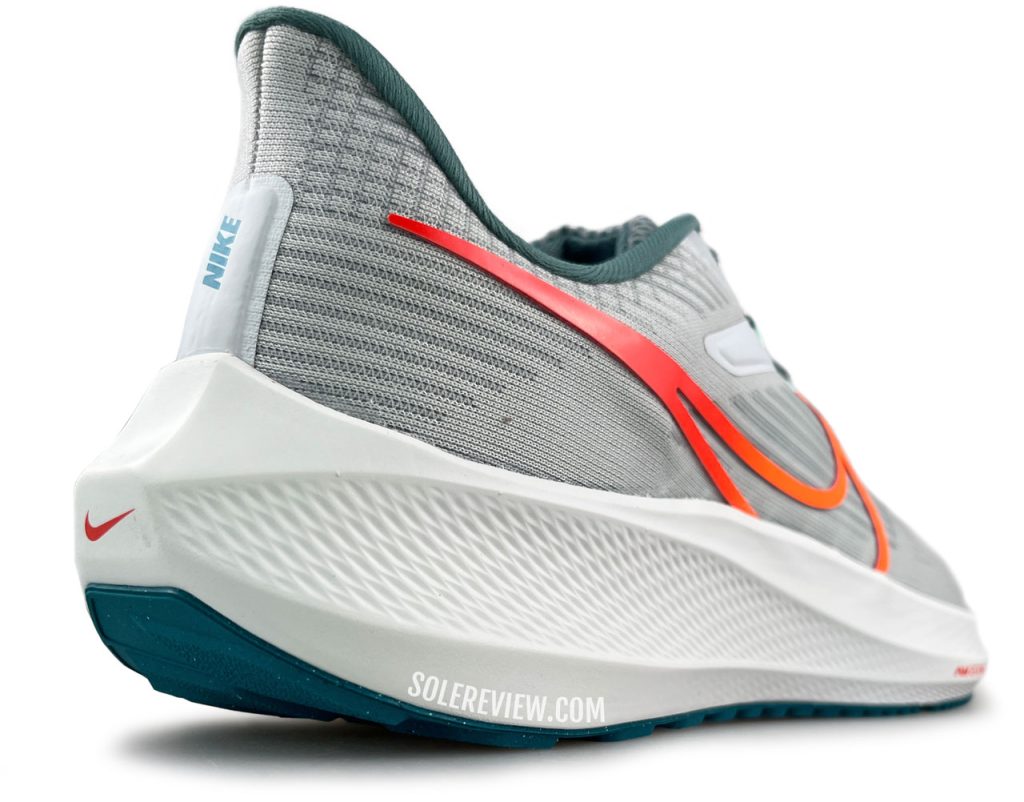
If you’re looking to buy just one daily trainer to do it all, the Pegasus 39 scores over the Turbo NXT.

If you’re looking to buy just one daily trainer to do it all, the Pegasus 39 scores over the Turbo NXT.
If you’re looking for just one running shoe to do everything, the Nike Pegasus 39 is a better choice. It’s $20 less expensive, has a superior upper fit, and grips the road better.
While the Pegasus 39 lacks the lively cushioning softness of the Pegasus Turbo NXT, its React + Zoom Air midsole offers a higher tier of stability and transitions.
Though the Turbo scores over the Pegasus 39 in ride comfort, the somewhat uncomfortable upper doesn’t compare favorably.
SHOES SIMILAR TO THE NIKE PEGASUS TURBO NEXT NATURE
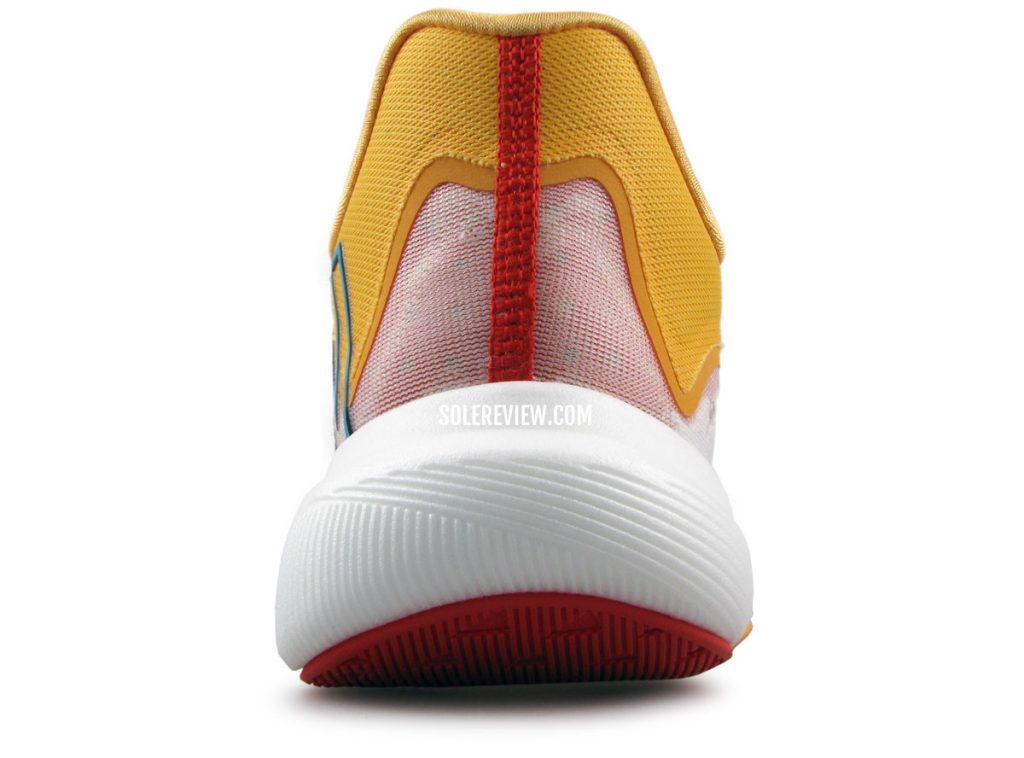
The durability issues aside, the Fuelcell Rebel V2 is what the new Pegasus Turbo should have been.
The New Balance FuelCell Rebel V2 comes to mind as a direct competitor. It’s lighter than the Turbo, and the midsole is soft and bouncy – just like ZoomX.
Other alternatives would be the Puma Liberate Nitro – a shoe that’s similar to the Rebel and much lighter than the Pegasus Turbo. However, it’s not as soft as the Turbo, and its thinner midsole stack brings it closer to a speed trainer than a cushioned everyday trainer that the Turbo is.
Or, you could go slightly off-category and opt for running shoes like Asics Novablast 2 – a cushioned, long-distance trainer with a rocker ride for quick transitions. If you prefer something firm and speed-friendly, the adidas Boston 11 or Brooks Hyperion Tempo are worth trying.
Do you own this shoe? Improve this review by sharing your insights – submit a review here.
